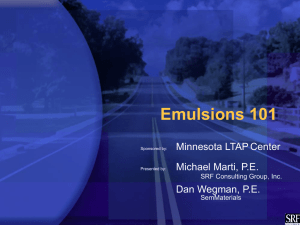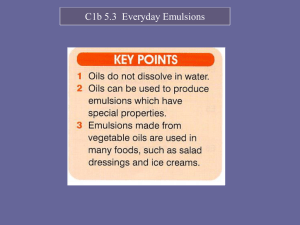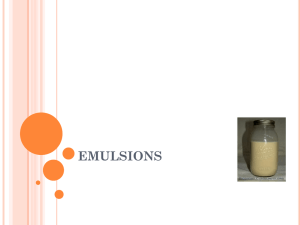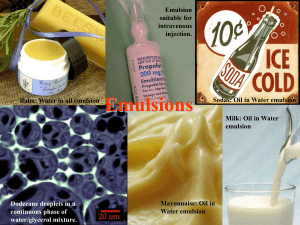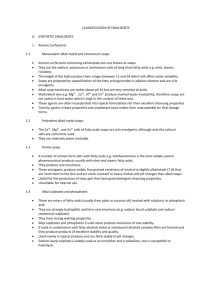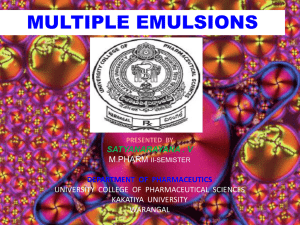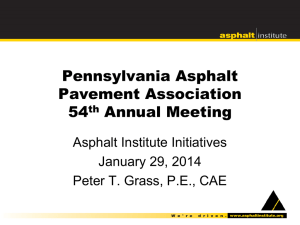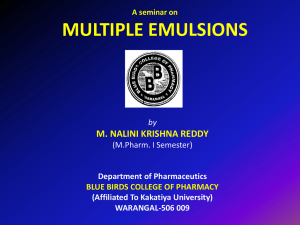Bitumen emulsions in India
advertisement
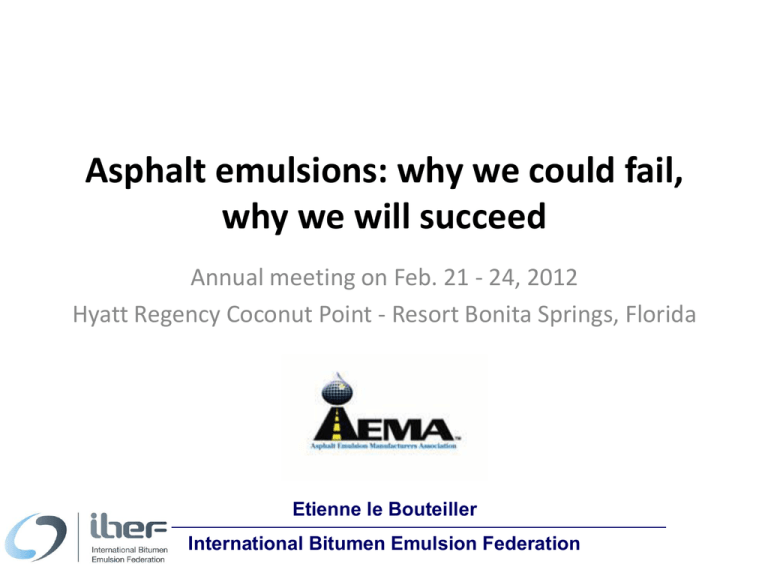
Asphalt emulsions: why we could fail, why we will succeed Annual meeting on Feb. 21 - 24, 2012 Hyatt Regency Coconut Point - Resort Bonita Springs, Florida Etienne le Bouteiller International Bitumen Emulsion Federation Weaknesses and strengths of the asphalt emulsion industry Annual meeting on Feb. 21 - 24, 2012 Hyatt Regency Coconut Point - Resort Bonita Springs, Florida Etienne le Bouteiller International Bitumen Emulsion Federation Outline • Introduction: what is IBEF? • A worldwide IBEF survey – – – – – What are the volumes and uses? What do our customers require? What about the reputation of our techniques? Is technical knowledge an issue? How do the techniques fit with the market? • Conclusions: common sharing and the role of the IBEF 3 What is IBEF? • International Bitumen Emulsion Federation • An association that gathers national associations dealing with asphalt emulsions • Individual members from countries with no association • IBEF represents more than 70% of the emulsion volumes worldwide 4 Where is IBEF? 5 Who is IBEF? • National associations dealing with asphalt emulsions • National associations dealing with asphalt industry and pavements • National associations dealing with road construction – SFERB/ USIRF (France), AMR (Morocco) • Individual companies – Insung (Korea), Ooms (Netherlands) 6 Some figures • Data collected for the WOE 2010 7 Some figures • Emulsion v/s Asphalt 14% 12% 10% 8% 6% emulsion v/s bitumen 2005 4% emulsion v/s bitumen 2009 2% 0% Europe Africa Asia Oceania America 8 Some figures • TOP 10 = 74% of the total volumes USA 26% France 29% Mexico Brazil China 2% Russia Spain Canada 3% 12% 3% India Japan 3% 4% 5% 5% 8% Others 9 A worldwide survey across IBEF members • The national association – Members, market share, • The market – Pavement preservation • The reputation – Communication and awareness • The technical knowledge – Contractors, engineers, owners • The techniques – Do they fit with the market 10 A worldwide survey across IBEF members • 19 questionnaires • 10 answers • Comments – Various situations – 2 common topics • Lack of funds allocated to road maintenance • Good reputation of the asphalt emulsion 11 National associations • A variety of associations • Members – From 8 (Japan, UK) to 230 (Italy) • Market share – Usually 75% - 100% • Some associations report how many plants that are operated within their country (UK, Japan, France) 12 The market • Do we know our market? – Volumes, uses • Yes we do – Japan (every month), UK & France (quarterly) – France & UK reports to differentiate spraying / mixing emulsions • No we don’t – USA, Australia • We estimate – Mainly in countries where there is no association (100 countries investigated for the 2010 WOE) – Industry, suppliers & traders: emulsifiers, liquid asphalt, equipment 13 The market • Do we know our market? – Volumes, uses • Yes we do – Japan (every month), UK & France (quarterly) – France & UK reports to differentiate spraying / mixing emulsions • Data collection through an intermediate independent third party • An attempt in the USA 14 The market • Emulsion is mainly designed for maintenance works • Road maintenance = pavement preservation • Level of owner awareness – Low in emerging market where the focus is on new construction – Fair in most of mature markets; lower attention at local level – High in countries such as Australia and in Korea where PMS is implemented – Politicians do not pay enough attention • Politicians – Politicians do not know the value of road assets – In the USA, “pavement preservation is included in the transportation bill now being debated in the Congress” (FP2) 15 The market • • • • • Emulsion is mainly designed for maintenance works Road maintenance = pavement preservation Conscientiousness of road owners Politicians Allocated funds – Insufficient… – South Africa: “Central Treasury now insists on road authorities having a PMS in place prior to allocation of funds” – India: “excise is imposed on sale of petrol and diesel. This money is used for pavement construction and preservation” 16 The market • Allocated funds are insufficient – Volumes are shrinking – Hot mix asphalt volumes are decreasing 600.00 hot and warm mix asphalt in the USA 500.00 400.00 300.00 200.00 100.00 0.00 1994 1995 1996 1997 1998 1999 2000 2001 2002 2003 2004 2005 2006 2007 2008 2009 2010 17 The market • Allocated funds are insufficient – Volumes are shrinking – Hot mix asphalt volumes are decreasing 320.00 310.00 hot and warm mix asphalt in the Eu 27 300.00 290.00 280.00 270.00 260.00 250.00 240.00 230.00 1994 1995 1996 1997 1998 1999 2000 2001 2002 2003 2004 2005 2006 2007 2008 2009 2010 18 The market • Allocated funds are insufficient – Japan: -50% v/s 2000 – France: ¼ of the needs for national roads • Needs for road maintenance are constant, increasing • “More for less” • A real challenge • How can the asphalt emulsions industry address this challenge? 19 The market challenge • Allocated funds are insufficient • Use the right technique in the right place • Example 1: “Guidelines for the preservation of High-TrafficVolume Road ways” technique Slurry seal Micro surfacing Chip seal UTFC HMA cost / yd2 $ 0.75 - 1.00 1.50 - 3.00 1.50 - 2.00 4.00 - 6.00 3.00 - 6.00 20 The market challenge • Allocated funds are insufficient • Use the right technique in the right place • Example 1: comparison South East of France technique Micro surfacing Micro surfacing 2 layers cost / m2 € 2.04 3.04 Chip seal Very thin asphalt concrete HMA 2.33 6.20 7.90 21 The market challenge • Allocated funds are insufficient • Use the right technique in the right place • Example 2: maintenance program for the Versailles district (France) 22 The market challenge • Allocated funds are insufficient • Use the right technique at the right place • Example 2: maintenance program for the Versailles district (France) 23 The market challenge • Allocated funds are insufficient • Use the right technique in the right place • Example 3: development of emulsion techniques v/s other asphalt based techniques in the UK 110 105 100 emulsion 95 AC 90 85 80 2005 2006 2007 2008 2009 2010 2011 2012 24 The reputation • Feedback from the enquiry is good • High credibility brought by the CME (World Congress on Emulsion) and WOE (World Of Emulsions) since 1993 • In Europe: increased credibility through the CE marking (factory production control) • But still a lot of work to do, and the backdrop is constantly evolving 25 The reputation • “Engineers and contractors are well informed and aware” (South Africa) • “Engineers at the federal and state agencies know about emulsion as a concept, some know the details. This is not the case with many local agencies” (USA) • “Most of [road engineers] have known that the asphalt emulsions are used only for tack coats” (Korea) • “Basically, they understand the concept of asphalt emulsion” (Japan) 26 The reputation • “Yes but it is still a battle, partly as the client has become more fragmented moving from mostly local & national authorities into outsourced consultant & contractor management of the network” (UK) • “Due to the turnover of road engineers in the road stakeholders, we have to train and educate the new generation” (France) • A never-ending story! 27 The techniques • In mature markets, the main uses for emulsions are surface treatments, typically chip seal and micro surfacing • Organic growth will come from mixes and recycling 28 The techniques • No technique has ever been prohibited for use after a technical failure • The market is demanding – Long term texture depth for micro surfacing – Lower noise chip seal – SBS modified emulsions to counter the use of hot applied modified binders (South Africa, Australia) – Trackless tack coats – Emulsion based mixes for wearing course and base course – Sustainable solutions 29 Emulsion based mixes 30 Chip seal • Strong development of the use of modified emulsions • Development in Europe chip seals in Germany chip seals in the United Kingdom 90% 90% 80% 80% 65% 70% 60% 50% 35% 40% 2001 25% 20% 30% 20% 67% 70% 60% 40% 80% 15% 2010 50% 2001 40% 30% 2010 22%20% 20% 10% 0% 0% 0% 6% 10% 0% 5% 0% 0% non modified emulsions modified emulsions non modified modified cut cut backs backs non modified emulsions modified emulsions non modified modified cut cut backs backs 31 Conclusion: the role of IBEF • To provide assistance in structuring teaching courses (Italy) • To spread the word & be as effective as possible (UK) • To keep its members informed of the latest technological developments and trends and growth of emulsions in global markets (South Africa) • To introduce (share) information about the new trend and techniques of asphalt emulsion in the world (Japan) • To give more and more inputs on newer applications of emulsions (India) 32 Conclusion: the role of IBEF • Trends and ideas for the future (Australia) • To continue to promote the use of emulsion by being an international platform for exchanging our best practices (France) – Cape Seal – Grave emulsion – Emulsion for railway tracks South Africa France Japan 33 Conclusion: the role & the future of IBEF • IBEF is and will be what its members want it to be and to become • A new logo, a new web site www.ibef.net 34 Conclusion: the role of IBEF 35 Acknowledgements to • • • • • • • • • • • • John Lambert Ichiro Iida Saied Solomons John Keayes Changwon Seo Jim Moulthrop A.S. Prabhakar Carlo Giavarini Jean Claude Roffé François Chaignon Yvonnick Brion Kh. Kasidis AAPA JEAA SABITA REA Insung FP2 Hincol SITEB SFERB Colas Nynas Tipco Asphalt Australia Japan South Africa United Kingdom Korea United States of America India Italia France France Sweden Thailand 36
